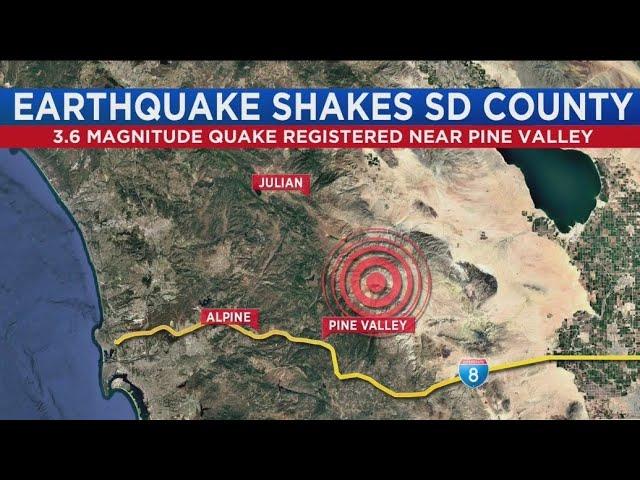A 3.6 magnitude earthquake was felt across San Diego County earlier today, causing brief tremors and prompting residents to check for any damage. According to the United States Geological Survey (USGS), the quake originated at a shallow depth near the eastern border of the county. While no injuries or significant structural damage have been reported, the event has renewed discussions about earthquake preparedness in the region. Authorities continue to monitor seismic activity as aftershocks remain a possibility.
San Diego County Residents Experience Moderate Earthquake Impact
Residents across San Diego County reported feeling the tremors caused by a 3.6 magnitude earthquake earlier today. Although no major damage was reported, many felt their homes shake and heard rattling noises, particularly in neighborhoods closer to the epicenter. Emergency services have confirmed that the impact was moderate, urging the public to stay alert but calm.
Key details from the incident include:
- Epicenter located near the coastal region, approximately 10 miles northwest of downtown San Diego
- Duration of shaking estimated at 10-15 seconds
- No immediate reports of injuries or structural damage
- Aftershocks remain a possibility, with advisories issued for preparedness
| Parameter | Details |
|---|---|
| Magnitude | 3.6 |
| Epicenter | Coastal area, 10 miles NW of downtown San Diego |
| Depth | 8 km |
| Duration | 10-15 seconds |
Seismic Activity Explained Experts Discuss Possible Causes and Patterns
Seismic experts attribute the 3.6 magnitude earthquake felt across San Diego County to the complex network of faults beneath the region. While the area experiences frequent minor tremors, this event has sparked renewed attention on possible triggers such as tectonic plate movement, natural stress accumulation, and even human activities like construction or underground water extraction. Geologists emphasize that Southern California’s landscape is shaped by the intricate interplay between the Pacific and North American plates, causing a range of seismic behaviors that can be sporadic but are often predictable in terms of fault line activity.
Data collected from recent and historical earthquakes reveal patterns that help scientists better understand risks and prepare communities. Key factors influencing seismic events in San Diego County include:
- Fault zones: the Elsinore and San Jacinto faults are among the most active nearby, capable of producing moderate to strong earthquakes.
- Stress transfer: shaking on one fault can increase stress on others, potentially triggering subsequent quakes.
- Seasonal variations: changes in groundwater and rainfall may subtly impact fault stability.
| Factor | Impact on Seismic Activity |
|---|---|
| Fault Zones | Direct source of earthquakes with varying magnitudes |
| Stress Transfer | Can cause clusters of tremors in nearby faults |
| Seasonal Variations | Potentially influence stress buildup and release |
Ongoing monitoring through seismic networks and satellite data continues to enhance early detection systems. Experts advise residents to stay informed and prepared, recognizing that although minor quakes like this one are relatively common, they provide valuable information about larger seismic risks in the region.
Emergency Preparedness Tips for Earthquake Safety in Southern California
Southern California residents are reminded to stay vigilant following the recent 3.6 magnitude tremor that rattled San Diego County. Experts emphasize the importance of having an emergency kit equipped with essentials such as water, non-perishable food, a flashlight, batteries, and a first-aid kit. Securing heavy furniture and appliances can drastically reduce injuries caused by falling objects during aftershocks. Additionally, familiarizing yourself with “Drop, Cover, and Hold On” techniques ensures quick protection when shaking begins.
To better prepare, families should establish clear communication plans and identify safe locations within their homes. Community centers and local authorities recommend following these key steps:
- Identify and secure potential hazards in every room.
- Practice earthquake drills quarterly with all household members.
- Keep copies of critical documents and emergency contacts accessible.
- Install seismic shut-off valves for gas lines to prevent leaks.
| Preparedness Item | Purpose | Recommended Quantity |
|---|---|---|
| Water | Hydration during outages | 1 gallon per person per day (3 days minimum) |
| Non-perishable Food | Sustain energy post-event | 3-day supply per person |
| Flashlight & Batteries | Visibility in power failure | 1 flashlight + extra batteries |
| First Aid Kit | Treat injuries until help arrives | Complete, replenished as needed |
Local Authorities Assess Damage and Advise on Precautionary Measures
Following the early morning tremor, local authorities swiftly mobilized emergency teams to conduct thorough damage inspections throughout San Diego County. Preliminary reports indicate minor structural damage in select neighborhoods, including fallen drywall, cracked sidewalks, and disrupted power lines. Officials urge residents to remain vigilant for potential aftershocks that could exacerbate existing damage and pose further risks.
Precautionary recommendations issued by county officials include:
- Securing heavy furniture and appliances to walls and floors to prevent tipping during aftershocks.
- Checking gas lines for leaks and turning off utilities if damage is suspected.
- Maintaining emergency supply kits including water, food, and medications for at least 72 hours.
- Staying informed through official channels such as local government websites and emergency alert systems.
| Area | Reported Issues | Response Status |
|---|---|---|
| La Mesa | Cracked roads, minor power outages | Inspections complete, power restoration ongoing |
| El Cajon | Fallen drywall, unsecured objects | Damage assessments underway |
| Poway | Shifts in pavement, water main checks | Emergency crews dispatched |
Concluding Remarks
As aftershocks continue to be monitored, officials urge residents of San Diego County to stay informed through trusted sources and follow safety guidelines in the event of further seismic activity. While no major damage has been reported so far, emergency responders remain on alert to assist communities as needed. Stay tuned for updates on this developing story.







